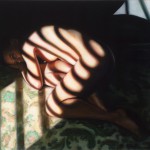Shadowlands Exhibition Essay 2007
“The atmospheric use of light and shadow is the defining element in my work – it creates a sense of mystery where questions linger. The women are lost in some deep world. Snippets of information lead into a narrative that only the viewer can unravel.”
Anwen Keeling October 2007
Seductive and mesmerizing, Anwen Keeling’s paintings possess a beauty that simultaneously disturbs and enriches our lives. Referencing sources as diverse as Caravaggio and film noir, the images appear like edited moments culled from the cutting-room floor. The familiar is scripted with unease: the uncanny conjoined with elegance. The viewer strains to grasp something as elusive as the dancing motes in a shaft of light.
The emotional context of the works is largely dependent upon certain pictorial dynamics. Compositions are carefully constructed with every line, shape and colour integral to the evocation of a desired mood. The young Sydney-based artist plays with light and its absence, deftly manipulating visual and psychological tensions with chiaroscuro. Drama and vulnerability become all the more palpable in Keeling’s extraordinary ability to render life-like form and sumptuous surface texture.
In the painting If Love Was a Red Dress, a figure momentarily pauses on dark wooden stairs – her upper face and eyes shadowed by the gloom ahead. Harsh light streams from a tall side-window and falls with cold sensuality upon the satin fabric of her garment: its crimson intensity swallowing the lonely emptiness of the stairwell. A tiny white patch flickers on the skirting board below, it and the fire extinguisher hint at an ‘out’ – a way back – but visual perspective and linear elements conspire to lead the subject inexorably forward.
A different sense of uncertainty pervades Approaching Storm. All is still in the wan, diffused light. A great watery expanse fills the entire view from the bay-windows. We intuit the approach of something. The homely scatter-cushions and neatly stacked fashion magazines do little to dispel the tug of an unsettling undertow. Bare floorboards direct the eye to the woman’s pointed toe, up along her body and thence out to where her binoculars are aimed: the angles formed by window frames and cushions reiterate. A stray palm-frond bobs into view and the water’s surface appears to ruffle in a lifting breeze.
Pictorial devices again guide us into the narrative of Drowsy Numbness. The golden light slanting through horizontal blinds is unabashedly theatrical. Stroboscopic-like patterns fragment reality with the fragility of some half-remembered dream. A similar, languorous ambiguity attends the imagery in Morning Sun. Mug of coffee in hand and dressed only in frilly red knickers, a young woman squints into the brightness of a new day – her naked flesh banded by the ruddy light spilling into unfurnished room.
Awash in moonlight, Night Solace has a mythic presence. Astride a great horse the girl peers into an impenetrable darkness. All senses alert in the cool night air, she gently pats the neck of her unconcerned companion. Glimmering white and reassuring against a shadowy unknown it grazes calmly on dew-damp grass.
Despite the enigmas and high drama, the Shadowlands exhibition radiates a warmth and honesty which is perhaps born of the fact that the models – both human and animal – are the artist’s very special friends.







